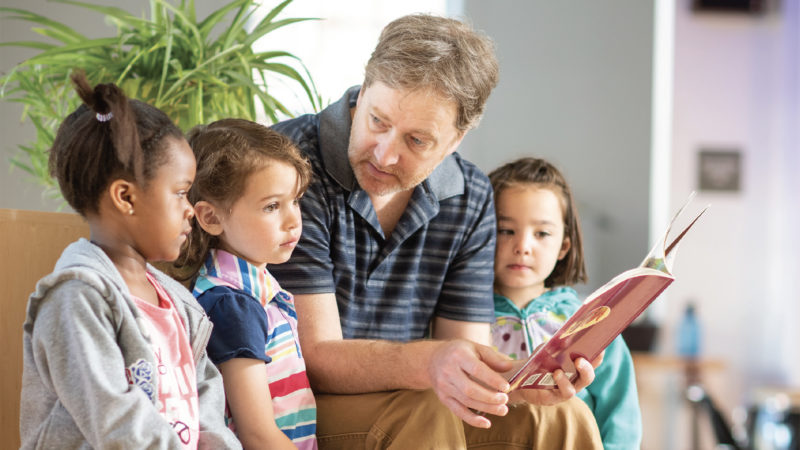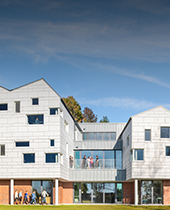7 Things to Consider When Choosing the Right Pre-K For Your Child
By Bob Mills, Debbie Rowe, Gretchen Schaefer (EC faculty)
Children who are three or four years old often find the transition from home to school easier if the environment, curriculum, and adults are engaging. At its best, school can harness young children’s vast curiosity, receptivity, and energy while nurturing their love of learning and school.
There are many fine pre-K programs in Greater Portland. How do you know which program will be right for your child and your family?
Here are seven important things to look for as you visit preschools:
1. How well will the teachers know your child?
You know that students are happiest in classrooms where they are known. Find out whether parents are given a chance to check in during drop-off or pickup times. Check the class size and the number of other teachers who will come to know your child and your family during those crucial years. Learn what you can about the depth of the faculty’s experience and the average tenure of teachers in the program.
At Waynflete, teachers spend two years with their small, multiage classes. This enables them to provide the kind of individualized instruction and sense of belonging children need in order to learn. Time spent together during morning drop-off also gives teachers a chance to get to know families, providing a deeper understanding of each child’s and family’s needs and expectations.
2. Who will supervise your child during breaks?
See who supervises your child during daily play, snacks, and lunch. Check how frequently students go outside for recess or other less-structured activities.
Unstructured times are critical to a thoughtful social curriculum. Teachers help students positively interact with each other during these times of the day, especially when they are beginning to move beyond parallel play. Waynflete’s Lower School educators are with their students throughout the day, inside and outside the classroom. They know when to insert themselves in student interactions, and when it’s best to step back and let children navigate social situations.
Studies show that play that allows kids to negotiate their own rules with each other is as critical as sleep is to cognitive development. To provide opportunities for this kind of self-directed learning, our preschool classes have at least three outdoor recesses a day (weather permitting)—midmorning, before lunch, and midafternoon.
3. How do the teachers manage their classes?
Try to visit on a day when school is in session. Look carefully at how classes are being taught. Evaluate the kind of noise you hear in the classroom. How are teachers maintaining discipline? What role do students play in their own learning?
When it comes to classroom management, Waynflete teachers believe the ideal way to manage their classes is by providing engrossing curriculum that excites their students. Students are given a great deal of choice in what they study in preschool; most of the time, there is a steady hum of students actively engaged in what they’re learning. There are few “shushes” in the Lower School. Teachers and students ask for quiet by simply raising their hands.
4. How is the classroom set up?
How a classroom is set up can tell you a lot about the kind of teaching that takes place there. What does the furniture arrangement suggest about how teachers and students interact? Would the types of activities you see appeal to your child?
At Waynflete, the environment is specifically designed to help three- and four-year-olds discover their own passions as learners. They can choose to compose songs on a piano in the conservatory, create sculptures in the art studio, or try their hand at a science experiment. Some prefer to spend time quietly practicing yoga, while others are more interested in the natural world.
Teachers intentionally design the classroom space to provide motivation for children to wander, explore, connect with others, take risks, and grow. Class materials are designed to encourage the independence and creativity of young learners. Time is allotted each day for students to discover their unique ways of expressing themselves.
5. How much choice will my child be allowed?
As parents, we want our child’s first school experience to nurture their natural curiosity and love of learning. Look for examples of child-directed learning in the classrooms you visit. See whether you would be inspired by the books, activities, or spaces. Listen for signs of collaboration, and whether knowledge is being “taught” or discovered. What is the energy level in the room?
At Waynflete, the day begins with an hour of free-choice time. Teachers prepare activities designed to spark student interest. There is another free-choice period on most days following teacher-directed learning times. After children complete their assigned projects, they can choose to do something else while their classmates finish their work.
6. How will teachers keep my child interested and engaged in learning?
Ask the professionals you meet how they keep children absorbed in learning throughout the school year. At Waynflete, we begin engaging children by creating a welcoming and visually compelling environment. Perhaps it is a table with natural objects, deep blue sand, or battery-operated candles that change colors. Maybe children listen to the song What a Wonderful World or the book Rabbit’s Gift. Once the children are intrigued, learning opportunities can emerge and grow.
The Reggio Emilia philosophy, which inspires our program, contends that essential skills are best learned when students are genuinely engaged in what they’re learning. We explore these interests through a variety of methods, allowing students to find their way using art materials, building materials, music, manipulatives, language, numeracy, and the outdoor world. This delicate dance between teachers and students—of listening and observing, and of children “making meaning of the world” with enthusiasm and vigor—is what makes a captivating classroom.
7. How does the school help your child make friends?
During the ages of three and four, children are typically transitioning from parallel to interactive play. This is a messy, beautiful time when they often discover their first friends. Ask the educators you meet how they help children find and make friends.
At Waynflete, we support this journey by creating an inclusive classroom that values kindness. We work hard to create an environment that not only makes it possible, but helps our youngest children recognize the connections that are being made.



